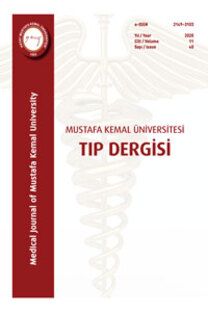LOMBER DİSK HASTALARINDA AŞIRI AKTİF MESANE SENDROMUNUN DEĞERLENDİRİLMESİ
Aşırı aktif mesane , lomber diskopati, , işeme bozuklukları
Assessment of Overactıve Bladder syndrome In Patients with Lumbar Disc Herniation
overactive baldder , lumber disc herniation , urinary disfunctions,
___
- Dündar Ü, Kavuncu V. Lomber disk hernisinde tanı ve tedavi. Klinik Aktüel Tıp Dergisi
- ;11(2):45-53
- Oğuz H. Bel ağrıları. Oğuz H (Editör). Tıbbi rehabilitasyon'da. İstanbul: Nobel Kitapevleri; 2004.
- s.1131-71
- Masaryk TJ, Ross JS, Modic MT, Boumphrey F, Bohlman H, Wilber G. Highresolution MR
- imaging of sequestered lumbar intervertebral disks. Am J Roentgenol 1988;150(5):1155-62
- Özorak A., Güzel A, Şenol N. Disk hernili ve spinal stenozşu hastalarda üriner sistem işlev
- bozuklukları Kadın ve İşlevsel Üroloji Bülteni Cilt 2 • Sayı 3 • 2012 29-30
- Abrams P, Cardozo L, Fall M, et al. The standardisation of terminology in lower urinary tract
- function: report from the standardisation sub-committee of the Interna- tional Continence Society.
- Urology 61: 37-49, 2003
- Coşkun E, Süzer T, Aybek Z, Turan T, Atahan Ö, Tuncay L, Şahin S. Correlation Of Neurological
- Findings And The Level Of The Lesions With Urodynamic Studies In Patients Having Spinal
- Pathologies Norol Bil 1999; 16: 1
- Bartolin Z, Gilja I, Bedalov G, Savic I. Bladder function in patients with lumbar intervertebral disk
- protrusion. J Urol 159: 969-971, 1998
- O’Flynn KJ, Murphy R, Thomas DG. Neurogenic bladder dysfunction in lumbar intervertebral disc
- prolapse. Br J Urol 69: 38-40, 1992
- Jensen R. Cauda Equina Syndrome as a complication of lomber spinal surgery. Neurosurgical
- Focus, 2004
- Kulaksızoğlu H., Kaptan H. Cauda Equina Sendromu ve İşeme Disfonksiyonları:
- Mevcut Literatur Işığında Patofizyoloji ve Klinik Yaklaşım Nöropsikiyatri Arşivi 2009; 46: 187-91
- Inui Y, Doita M, Ouchi K ve ark. Clinical and radiologic features of lumbar spinal stenosis and
- disc herniation with neuropathic bladder. Spine 29: 869-73, 2004
- Tsai CH, Chou ECH, Chou LW ve ark. The evaluation of bladder symptoms in patients with
- lumbar compression disorders who have undergone decompressive surgery. Spine 35(17):849-854,
- -
- ISSN: 2149-3103
- Yayın Aralığı: 3
- Başlangıç: 2010
- Yayıncı: Hatay Mustafa Kemal Üniversitesi Tıp Fakültesi Dekanlığı
NADİR GÖRÜLEN BİR BENİGN YUMUŞAK DOKU TÜMÖRÜ; ELASTOFİBROMA DORSİ
Ömer Yıldız, Raif Özden, İbrahim Duman, Vedat Uruç, Yunus Doğramacı, Aydıner Kalacı
Gökhan Arslan, Ali Karakuş, Koca Çalışkan, Mustafa Şahan, Mehmet Duru, Güven Kuvandık, Yakup Erdoğan
NEURONAVIGATION: A REVOLUTIONARY STEP OF NEUROSURGERY AND ITS EDUCATION
EŞ ZAMANLI 2 AYRI ODAKTA KÜÇÜK HÜCRELİ AKCİĞER KARSİNOMUYLA BAŞVURAN SINIRLI EVREDEKİ BİR OLGU
KLİNİĞİMİZE BAŞVURAN MOL GEBELİK OLGULARININ RETROSPEKTİF İNCELENMESİ: 5 YILLIK KLİNİK DENEYİM
Atilla Karateke, Raziye Kurt, Mehmet Dede, Ayhan Gül, Çetin Kılıç, Defne Özkaya
ISOLATED TRANSVERSE SACRUM FRACTURE AND ITS IMPLICATIONS: A CASE REPORT
Mustafa Özçil, Arif Güngören, Ali Hakverdi, Hasan Gökçe, Orhan Nural
LOMBER DİSK HASTALARINDA AŞIRI AKTİF MESANE SENDROMUNUN DEĞERLENDİRİLMESİ
